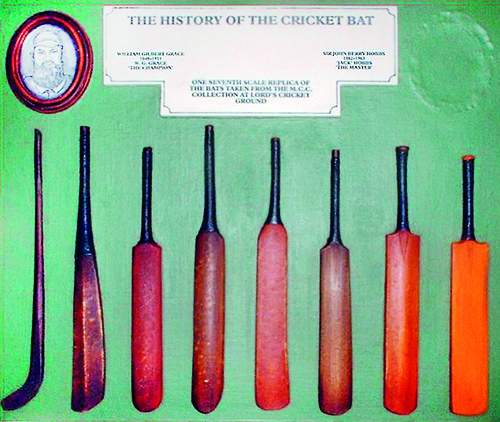DRS a key stage in cricket’s evolution
View(s):Well it’s not everyday that you hear nice things about the local cricket administration, especially things that could have a direct bearing on the game itself. If not what emanates is about how someone closed the deal with a pint in his pocket or some other crooked act that has come to light.
The news is that the local cricket administration has coaxed the Ten Sports management to throw in the package of the Umpires Decision Review System (DRS) which the International Cricket Council is expecting to have at international exchanges with the host country bearing the cost.
Until now the DRS seemed to be the divider between the haves and the have-nots in the international cricket community, barring India (We could take that matter up a little later).

The revolution of the cricket bat
In countries like England, Australia and South Africa the new system was accepted and was put into action as a matter of practice. But, Sri Lanka and some other not-so-rich full members did not make full use of the system – mainly because of the costs involved, which works to around US$ 80,000.
Primarily the question that comes to mind is “What’s so special about the DRS?”
The reason for the DRS to see the light of day was another step in the evolution of the game. Unlike most sports, cricket has faced changes in many ways. Cricket historians believe that English shepherds in the middle ages were bowling or rolling balls of rags or wool at a target. Often the sheep paddock’s wicket gate was used for the purpose. At the other end the batting shepherd defended the wicket with their crooked staffs. Well, the first cricket bat was more like a hockey stick rather than a modern cricket bat.
From the shepherds the game evolved to be played among the gentlemen and the ladies of the English aristocracy. Initially the ball was delivered to the batsman underarm. Then one day when a lady who could not deliver the ball owing to the puffed can-can dress she was wearing rolled the ball over her shoulder. Well that could be termed as one of the most defining points of the game of cricket, which has evolved to become a multimillion dollar professional entity. While the game was evolving, the judges — or simply the umpires also began to play an important role. However, by the time it came to the mid-1970s home umpires manned the slots, and in the 1980s it gradually transformed into the ICC controlled neutral umpiring system – a call which was pioneered by former Pakistan cricket captain Imran Khan.
The more professional the game became, scrutiny of the umpiring decisions also became very focal. It became so focal by the turn of the millennium that the ICC mooted its cricket committee to devise a system which would take the umpiring accuracy levels from the then prevailing 93% to almost 99%.
After working on several formulas the ICC finally zeroed in on the DRS and in 2008 it tested the innovation when India toured Sri Lanka for a Test series. The Lankans almost mastered the system from the very beginning. The Lankans won the two matches played at the SSC and the P. Sara Oval while India won the second Test in Galle thanks to a defiant double century by opener Virendra Sehwag. The double ton was so much more valuable than an ordinary Indian hundred because it was scored under the trying conditions in Sri Lanka and with the DRS in operation.
However, with that bad experience the Indians severed all connections with the system and remain vehement foes of this development.
A while after testing it in Sri Lanka, the ICC ruled that every international series should adopt the DRS, but under the barrage of protests from India the wise guys of ICC retreated and came with a diluted version where the system could only be in operation with the consent of both involved parties.
 Here the ICC erred twice. The first was by giving into India’s unreasonable demand and then by asking the member state to foot the bill if the system is put into operation in a home tour.
Here the ICC erred twice. The first was by giving into India’s unreasonable demand and then by asking the member state to foot the bill if the system is put into operation in a home tour.
I remember England’s last tour to Sri Lanka when the DRS was in force, but in this instance SLC, Ten Sports and the ECB pooled their resources to cover the expenses.
However, India’s apathy against the DRS kept growing. In 2011, hot from winning the World Cup and also at No 1 at Test ranking, India faced a horrendous all lost four Test series against England. In this tour the only Indian batsman to show some spunk was Rahul Dravid who scored three magnificent centuries. But, in the last inning of the fourth Test there was an incident. Dravid was out caught bat and pad. Initially it was ruled not out but England reviewed. The ball spun back from outside off stump and passed very, very close to the bat before going onto pad and looping to Cook who palmed it with one hand and collected the catch off the bowling of Swann. India lost that Test also by an innings.
At the next ICC meeting when the DRS came up for discussion, an angry Indian official called it the “Dravid Removal System”.
Thereafter wherever India plays, the series goes without DRS.
Here, India’s contention is that if the DRS is in force, it should have no faults of it own. But, how can you perfect a system if it is not put in use at practical level. If the system is to be established at the Test level it should be tested at that level. Anyway the system is too costly to have at the other levels of the game. Then if India has the betterment of the game at heart it should shoulder the system and give its input rather than acting like a down town thug. Generally what is occurring now is when India growls, the rest of the flock falls in line. If not one who decides to work close to heart finds the warmth of the curb outside his office rather than the high-backed comfortable office chair which he was used to. Two persons we very well know suffered the ignominy. They are Arjuna Ranatunga and Haroon Lorgat. Both crossed the Indian path and lived to learn the repercussions of it.
Cricket is an evolving game. I bet in another 50 years the game would be completely changed and if a person from this era moves to that he may think that he is watching some other recreation. Yet, it will suit the needs and the tastes of that time. Once again well done SLC, this is one good move you have made.



